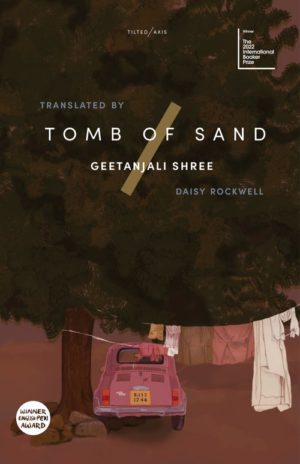You have no items in your cart. Want to get some nice things?
Go shopping
“Once you’ve got women and a border, a story can write itself.”
From the first page of Geetanjali Shree’s Tomb of Sand, we know the end: “There are two women and one death.” It is Shree’s fifth novel, and the first to be published in English in the United Kingdom, where it recently won the International Booker Prize. It follows Ma, an octogenarian who retires to bed after the death of her husband and, for the first third of the book, simply refuses to get up.
“When footsteps neared the room, she’d turn her back, she’d stick to the wall. She’d play dead, eyes and nose closed, ears shut, mouth sewn, mind numb, desires extinct; her bird had flown.”
Also among the operatic cast are her eldest son Bade, his wife Badu, and their sons, Siddharth (the favourite) and “Serious Son,” who later becomes “Overseas Son” when he (you guessed it) moves overseas. There is also Ma’s daughter, Beti, who lives alone and travels often, and whose unorthodox “bohemian” life as a journalist is a source of family consternation. Her family is unsure of what to think of her work, “if it even is work,” which will certainly amuse readers like myself facing the same familiar skepticism. And then there is Rosie Bua, a hijra, whose friendship with Ma feels both unexpected and fated.
These and other named and unnamed characters – including birds, beasts, a cane, and a pair of Reeboks – form a swirling narrative around Ma, who lies catatonic in bed while the reader either endures or is entertained by endless digressions. “Enough,” the narrator says, “Let’s get back. Though the tale has no need for a single stream.”
The beginning of the book is largely concerned with introducing us to Ma’s upper-class family living in the Hindi Belt in Northern India, their tribulations, their quirks, and their inner lives and motivations. It also includes wry depictions of the place of women in the family and the attitudes of men: There is a long, bemusing, vaguely sinister account of Serious Son’s inability to laugh. Ma’s son Bade insists that fresh food be cooked every day, snapping at the maid and his wife Bahu in turn, insisting that leftovers are poisonous. Rosie Bua, a transgender or third gender hijra, is viewed with suspicion. Around the men, the feminine characters tread a thin line between invisibility and defiance. Ma sinks into a depressive oblivion after her husband’s death; Beti tries valiantly to drum up enthusiasm for her brother Bade’s chrysanthemums to humour him; Badu says nothing of her annoyance with her husband but tenses up and snaps about meaningless things: “If you have to keep quiet but aren’t quiet inside,” writes Shree, “sounds come bursting out of other places.”
The women’s defiance is first seen in Beti. No is Beti’s word, “her birthright,” a word that amused people in her childhood, but which annoyed them when she dragged it into adulthood:
“…[H]er no grew up with her. No, I won’t sew, no, I won’t wear a dupatta, no, I won’t be locked up, no, I’m not you.”
Ma’s depression and retirement to bed is seen as her No, much to her daughter’s dismay:
“The word [No]–once so useful in my life – must have been dislodged from the dust where it lay, but it’s not that special anymore, because one must have someone to say it to, and I’m my own master now…but it belonged to me and only me, so how did Ma get her hands on it?”
Yet it is the same No that moves her finally to abandon her bed and “rise anew”: the middle section witnesses Ma’s rebirth. She develops a deep friendship with Rosie Bua – who calls her Baji (elder sister) – and moves in with Beti, who grapples with their role reversal. Ma seems to get younger every day, stops wearing her saris, speaks with the birds and laughs easily, while Beti senses she herself is getting older, more conservative. The No that defined her character as a child and young woman has passed to her mother, childlike in old age.
But speaking of the plot in this way is misleading. Tomb of Sand is not for everyone, as it abandons many of the narrative conventions we find reassuring: time, space, even character. It requires attention, a willingness to be immersed in a pseudo-magical world for long periods of time, and an openness to digression. It helps that the narrator’s voice is kind and conspiratorial – like Milan Kundera or Hamid Ismailov, you get the feeling the narrator is winking at you from behind the page. It has a gentle, wayfaring tempo of a journey replete with interminable interruptions. I’m reminded of Tolkien at his lightest and most meandering – of journeys there and back again – where storytelling, not plot, is at the centre of the human experience.
Many critics have commented on the materiality of Shree’s language, some with pleasure and others with despair. I think it is a delight to read aloud, if you’re so inclined, and to feel the words morph and elongate in the mouth: “Dry earth cracks nightingales rise gurling springs surface.” Prose shifts into poetry to create a world that incites all the senses. From the start, I felt an awestruck admiration for translator Daisy Rockwell, who fashioned a masterpiece in English that navigated the extensive use of wordplay and linguistic recreation in the original Hindi:
“No, no, I won’t get up. Noooooo, I won’t rise nowwww. Nooo rising nyooww. Nyooo riiise nyoooo. Now rise new. Now, I’ll rise anew.”
No is repeated ad nauseum, mantra-like, until it transforms: “A path opens with no. Freedom is made of no.”
It is worth mentioning that Rockwell’s translation is nearly twice the length of the Hindi original. She has done the reader the welcome favour of introducing more blank space, places to pause and reflect – without which we would be sucked into the book’s trance-like cadence, likely for days. “A translation is an interpretation, a refraction, a reworking, and as such it contains something old, but also contains something new,” Rockwell notes in an interview in The Beacon. I think there is a lot to be gained by taking this to heart; of course, many words are wasted arguing the value of a translation’s fidelity to the original. Rockwell’s approach seems more in line with adaptation scholar Linda Hutcheon’s notion of “repetition with variation,” in which the resulting text has the “comfort of ritual combined with the piquancy of surprise.” Discourse on fidelity tends only to create a false hierarchy between different ways of telling a story. There are echoes of this in the book itself, as the perspective shifts from humans to doorways to a gathering of crows in a tree – all variations on a theme that add to the musicality of the whole, and where none of the variations is more truthful than the other.
“If you are a writer it becomes your way of being to have stories imbue your senses all the time and also to realise that everything is a story and everything tells a story,” Shree says in her Booker Prize interview, as a way of explaining this free-flowing narration. There are no real borders between characters (animate and inanimate) or countries or stories – this is pure, uninhibited language, shifting between prose and poetry, and even English and Hindi, as Rockwell litters the texts with the “occasional fragment of the original that was too good to leave behind.”
But Shree’s buoyant prose is floating on top of a cold, dark ocean. The final third of the story takes us to the border between India and Pakistan. Tomb of Sand follows a long lineage of partition literature, and though the land was cleaved in two upon India’s independence from Britain in 1947, the history of the event is little known to many anglophone readers in the West. Some tens of millions of people were displaced, forced to abandon their homes, their families, and the landscape of their roots. Ma and Beti cross the border into Pakistan, and eventually Ma makes her way to Khyber-Pakhtunkhwa, searching for her ex-husband and, ostensibly, for the part of herself hewn off by the border’s enforcement. Even with Shree’s characteristic lightness of spirit, we are still confronted by the unhealed border wound – the longing and the loss.
In the end, it was the death of a partridge that made me weep. All of Shree’s playfulness and levity had, for 600 pages, kept the story’s darkness at bay. As is often the case, I wasn’t only weeping for the partridge, but for everyone. Ma’s journey embodies both heaviness and light and presents them together as a whole – a remarkable feat of storytelling. Tomb of Sand is a poet’s novel, exquisitely modern, and not in that thorny Joycean way. It venerates eccentricity, laughs at its own ingenuity, and blurs borders in language and life. That, for some readers, will make it a future classic. “Marvelous beings, stories,” the narrator says. I can’t agree more.
by Geetanjali Shree,
Translated by Daisy Rockwell
Tilted Axis Press, 739 pages

Hannah Weber
Hannah Weber is a German-Canadian writer and critic. She has published work in World Literature Today, Words Without Borders, Asymptote, and The Calvert Journal, among others. She lives on the south coast of England.
- Web |
- More Posts(1)




